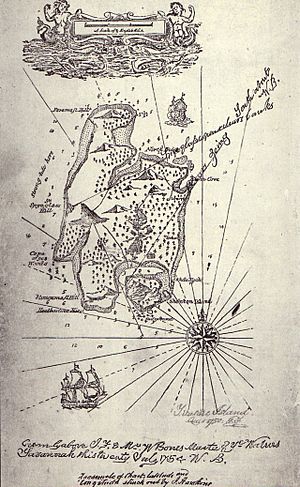Treasure map facts for kids
A treasure map is a special map that shows where something valuable is hidden. This could be buried treasure, a secret mine, or a hidden place. In stories, these maps often look old and have strange clues. They usually lead to pirate gold! Even though they are popular in books and movies, real treasure maps are very rare.

Contents
Real-Life Treasure Maps and Legends
The Ancient Copper Scroll
One of the oldest known documents that lists hidden treasure is the copper scroll. It was found in 1952 among the Dead Sea Scrolls near Qumran. Experts believe it was written around 50 to 100 AD.
This scroll describes 63 different places where gold and silver treasures are hidden. It even gives detailed directions! Here is a small part of what it says:
1:1 In the ruin which is in the valley of Acor, under
1:2 the steps leading to the East,
1:3 forty long cubits: a chest of silver and its vessels
1:4 with a weight of seventeen talents.
So far, none of the treasures mentioned in the scroll have been found. Scholars are still discussing if the copper scroll describes real hidden treasures and who might have owned them.
Pirate Treasure: Fact or Fiction?
Buried pirate treasure is a very popular idea in books and movies. However, there are very few real stories of pirates actually burying their treasure. And there are no real pirate treasure maps from history!
One famous pirate linked to buried treasure is Captain Kidd. The story goes that Kidd buried treasure from a ship he plundered on Gardiner's Island in New York. This happened before he was caught and sent to England for trial.
Much of Captain Kidd's treasure was actually found. It was taken from people who were keeping it safe for him. But because his trial was so public, many people believed a huge fortune was still hidden. Captain Kidd did bury a small amount of treasure on Gardiner's Island. But the governor quickly dug it up and sent it to England as evidence. Many people have searched for Captain Kidd's hidden treasure over the years, but no one has ever found it.
The Legend of El Dorado
In 1595, the English explorer Sir Walter Raleigh went looking for the legendary city of El Dorado. This city was said to be made of gold! Of course, Raleigh never found it.
However, Raleigh wrote a long book called The Discovery of Guiana. In it, he claimed he came very close to "the great Golden Citie of Manoa (which the Spaniards call El Dorado)." Even though his story included strange things, like a tribe of headless people, people respected him.
Because of Raleigh's reputation, other mapmakers used his ideas. Jodocus Hondius included El Dorado on his 1598 map of South America. The city stayed on maps until 1808! This led to many failed searches for the golden city.
Treasure Maps in Stories and Movies
Treasure maps are very common in fiction. They often appear as old, torn charts with an "X" marking the spot. This idea became popular with Robert Louis Stevenson's book Treasure Island (1883). Sometimes, a map can be a tricky puzzle, like in Edgar Allan Poe's "The Gold-Bug" (1843). Or it might even be a tattoo leading to a safe place, as seen in the movie Waterworld (1995).
In Literature
Treasure maps are useful tools for writers in many ways:
- Motivation: They make characters start an exciting adventure or quest.
- Plot Guide: They show characters where they need to go on their journey.
- Tracking Progress: They can show how far the characters have gone in their quest.
- Challenges: They can include riddles or puzzles that characters must solve.
- Conflict: They can create problems, like bad guys trying to steal the map.
Robert Louis Stevenson made the treasure map idea very famous in Treasure Island. But he wasn't the first to use it. James Fenimore Cooper's 1849 book The Sea Lions also featured old maps. These maps led to a seal-hunting spot and a place where pirates buried treasure.
In Film
Treasure maps have been a big part of many movies:
- In Romancing the Stone (1984), a writer goes to Colombia to save her sister. She quickly finds herself on a dangerous adventure because of a map.
- In The Goonies (1985), an old treasure map leads a group of kids to the secret stash of a legendary pirate.
- Waterworld (1995) features a very unclear treasure map tattooed on a child's back. This map leads the characters to dry land, which is the "treasure" in the movie.
- In The Road to El Dorado (2000), two main characters win a map to the lost city of gold. They find the city, are mistaken for gods, and then help keep the city a secret.
- In National Treasure (2004), finding a hidden treasure map starts a quest for a treasure from the Colonial era.
- In National Treasure: Book of Secrets (2007), treasure hunter Benjamin Gates uses an old map to find the lost city of Cibola.

